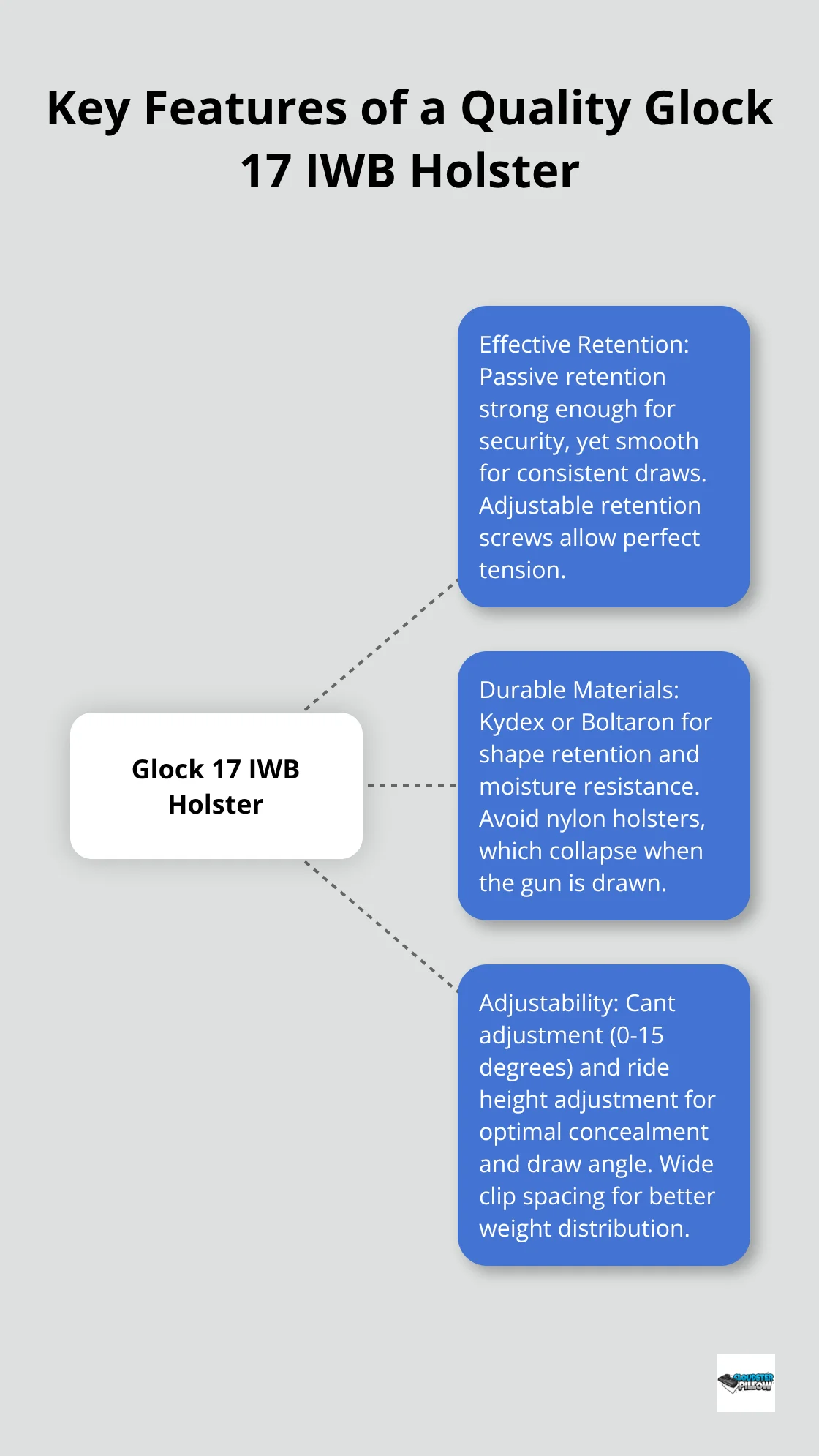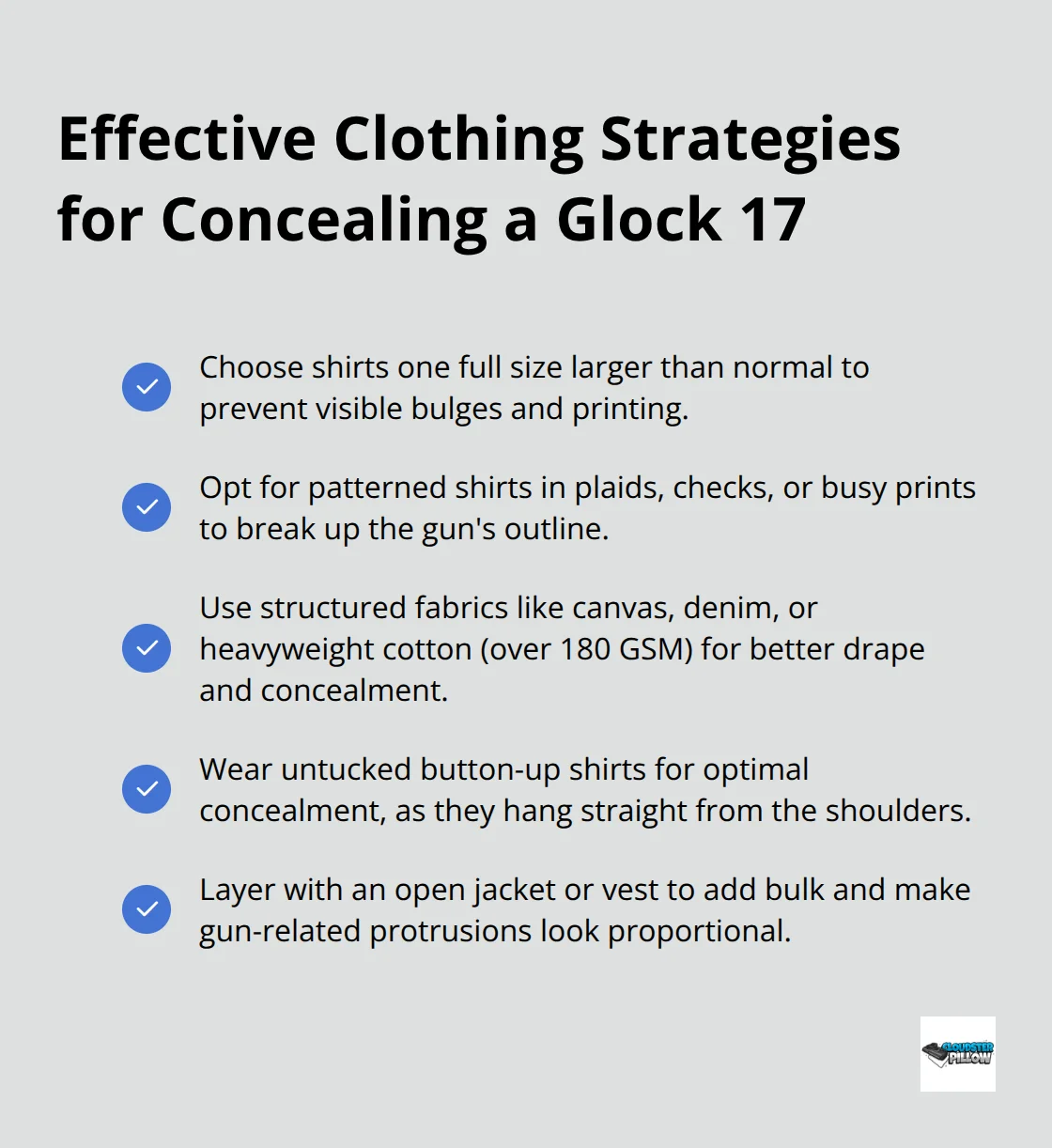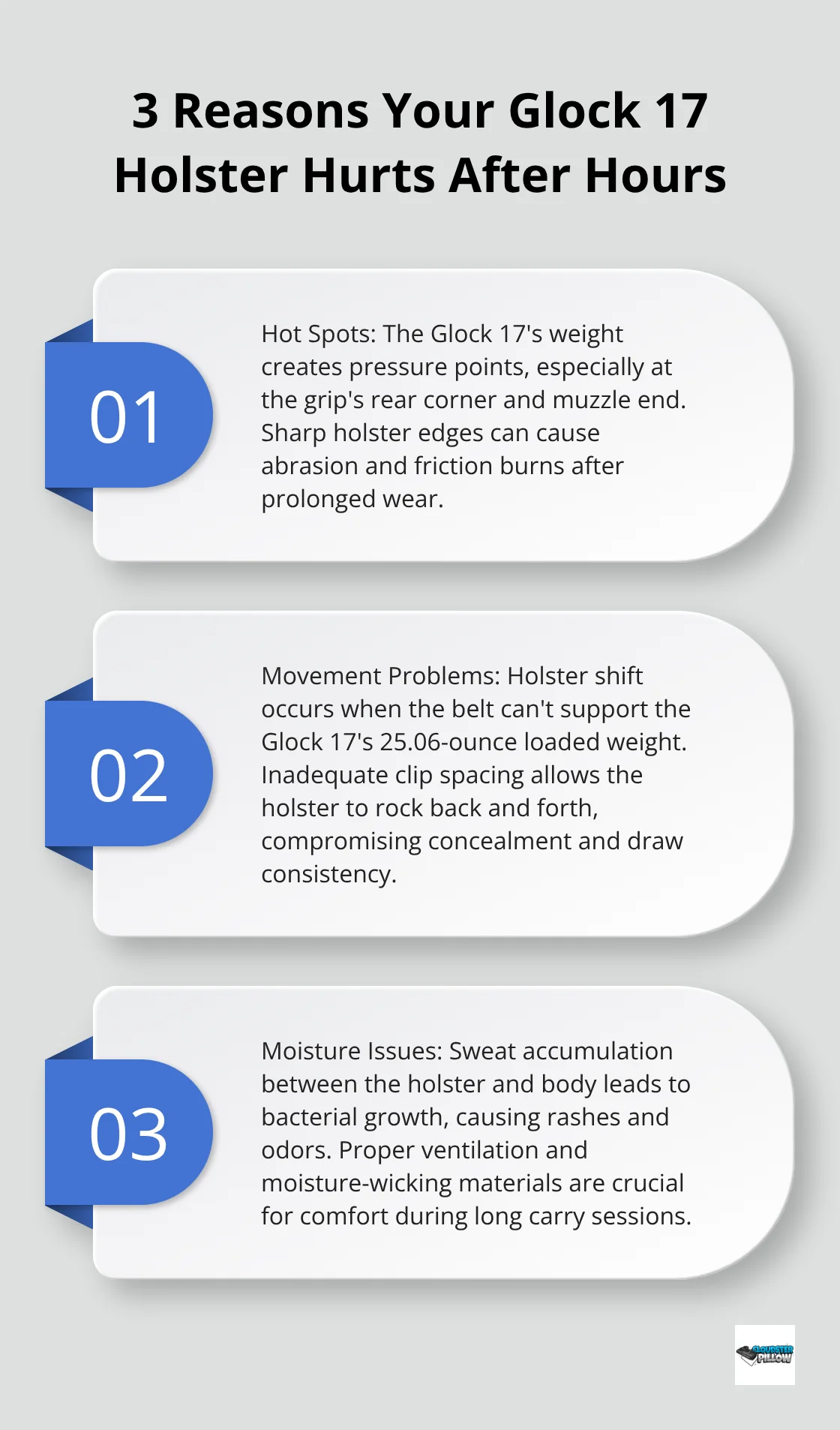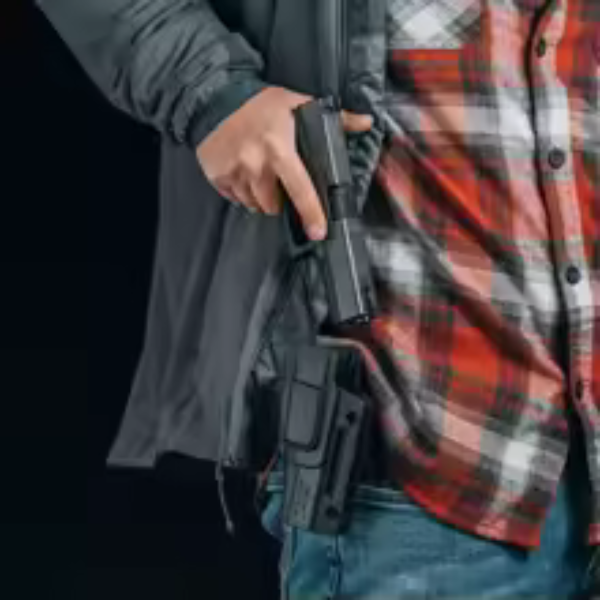Holsters and Gear Recommendations
Glock 17 IWB Holster
The Glock 17 remains one of the most popular full-size pistols for concealed carry, but finding the right IWB holster can make or break your carry experience.
Choosing the right Glock 17 holster is crucial for every gun owner.
We at Cloudster Pillow understand that comfort and concealment challenges multiply with larger firearms. The wrong Glock 17 holster setup leads to printing, discomfort, and inconsistent draw strokes that compromise your defensive readiness.
The Glock 17 holster you choose should enhance your comfort and concealment.

What Makes a Glock 17 IWB Holster Worth Your Investment
Retention That Actually Works
Your Glock 17 holster needs passive retention strong enough to keep your firearm secure during physical activity, yet smooth enough for consistent draws. Adjustable retention screws allow you to dial in the perfect tension-tight enough that the gun won’t fall out if you turn upside down, loose enough for a clean one-handed draw.
Many users report that the Glock 17 holster is essential for effective carry.
Skip holsters with active retention buttons or thumb breaks for IWB carry. These mechanisms slow your draw and create failure points when you need your firearm most. Quality holsters use precise molding around the trigger guard and ejection port to create natural retention points without gadgets.
Materials That Stand Up to Daily Carry
Choosing durable materials for your Glock 17 holster will ensure it lasts.
Kydex dominates the IWB market for good reason. This thermoplastic maintains its shape in extreme temperatures, resists moisture, and provides consistent retention over thousands of draws. Boltaron offers similar performance with slightly better impact resistance.
Leather holsters feel comfortable initially but stretch over time, which compromises retention and creates safety concerns. Hybrid designs that combine Kydex shells with leather backing give you durability where it matters most while they provide comfort against your skin. Avoid nylon holsters completely-they collapse when the gun is drawn, which makes reholstering dangerous.
Adjustability That Adapts to Your Body
Cant adjustment between 0 and 15 degrees forward lets you position the grip for optimal concealment and draw angle. Ride height adjustment moves the entire holster up or down on your belt, which affects both comfort and accessibility. Most carriers find success with the grip that sits just below their belt line.
Clip spacing matters more than most realize-wider spacing distributes weight better and reduces holster movement during daily activities. Look for adequate spacing between attachment points on full-size holsters (this becomes even more important with heavier firearms like the Glock 17).
These foundational features set the stage for successful concealment, but even the best holster fails without proper body positioning and carry techniques. Holster wedges can significantly improve comfort and concealment by adjusting how the holster sits against your body.
How Body Type Affects Glock 17 Concealment
Your Glock 17 holster should fit your body type perfectly for optimal concealment.
Position Selection Based on Your Build
Appendix carry works best for carriers with minimal belly fat and longer torsos. The Glock 17’s 7.32-inch overall length requires adequate space between your belt line and natural waist crease. Carriers under 5’8″ often struggle with appendix positions because the grip extends too far up their torso and creates obvious print through shirts.
Strong-side carry at the 3-4 o’clock position accommodates more body types effectively. Heavier carriers find success here because their natural hip curve helps break up the gun’s outline. The 4 o’clock position specifically works well for office workers who sit frequently, as it prevents the grip from digging into their side when seated.
The right Glock 17 holster can make a significant difference in your carry experience.
Clothing Strategies That Actually Hide Your Gun
Your shirt needs to be one full size larger than normal when you carry the Glock 17 IWB. Standard-fit clothes create visible bulges and print that telegraph your carry status. Patterned shirts in plaids, checks, or busy prints break up any outline better than solid colors.
Consider how your clothing choices will affect your Glock 17 holster’s concealment.
Avoid thin fabrics like cotton blends under 180 GSM weight-they cling to your holster and show every detail. Structured fabrics like canvas, denim, or heavyweight cotton maintain their shape and create natural drape that conceals effectively. Untucked button-up shirts provide the best concealment because they hang straight down from your shoulders rather than follow your body’s contours like t-shirts do.

With the right Glock 17 holster and clothing, you can achieve seamless concealment.
Layer with an open jacket or vest when possible. This adds bulk that makes any gun-related protrusion look proportional to your overall silhouette.
Draw Technique Modifications for Larger Frames
Practice your draw with the specific clothes you wear daily. Sweaters and hoodies require different hand positions than thin shirts because you need to clear more fabric. Grip the bottom hem of your cover garment with your support hand and lift straight up-don’t sweep it to the side where it might catch on your draw.
Your strong hand should establish a full fire grip before you start to pull the gun from the holster. This prevents fumbles and maintains consistent hand placement under stress. Train with a shot timer to measure your progress. Most experienced carriers achieve sub-2-second draws from concealment with proper practice.
Even with perfect body position and draw technique, comfort issues can derail your carry routine and create dangerous habits that compromise your safety.
Why Your Glock 17 Holster Hurts After Hours
Sometimes, your Glock 17 holster can become uncomfortable if not chosen wisely.
Hot Spots That Ruin Your Carry Day
The Glock 17’s weight creates specific pressure points that lighter guns never cause. The grip’s rear corner digs into your hip bone during appendix carry, while the muzzle end creates a painful hot spot against your thigh. These pressure points worsen throughout the day as your holster settles and your belt tightens from normal body movement.
Pay attention to hot spots that your Glock 17 holster may create during wear.
Sharp holster edges amplify these problems. Kydex holsters with rough-cut edges create abrasion points that turn into raw spots after 8-10 hours of wear. Rigid holster edges scrape against your skin with each step, creating friction burns and tender spots. Sand these edges smooth with 400-grit sandpaper, or choose holsters with rounded edges from the factory. Quality holsters protect your body from sharp components and eliminate metal-on-skin contact.
Movement Problems That Kill Concealment
Your Glock 17 holster’s stability is crucial for effective concealment.
Holster shift happens when your belt can’t support the Glock 17’s 25.06-ounce loaded weight. Standard dress belts flex and stretch, which allows your holster to migrate throughout the day. This movement changes your draw stroke and creates inconsistent concealment. Gun belts with internal cores prevent this flex and keep your holster positioned exactly where you placed it.
Clip space under 3 inches creates a pivot point that lets your holster rock back and forth with each step. Wider clip space distributes weight better and creates stability. Single-clip holsters work for compact guns but fail with full-size frames like the Glock 17. The physics simply don’t support consistent position with inadequate attachment points.
Moisture Management That Actually Works
Moisture management is vital when using your Glock 17 holster daily.
Sweat accumulation between your holster and body creates bacterial growth that causes rashes and unpleasant odors. Kydex holds moisture against your skin, while leather absorbs sweat and stays damp for hours. Hybrid holsters with moisture-wicking materials move sweat away from your body and allow air circulation.
Antimicrobial treatments on holster materials prevent bacterial buildup, but proper ventilation works better than chemical solutions. Holster wedges improve airflow by creating space between the holster and your body, which reduces moisture retention and heat buildup that makes long carry sessions uncomfortable.

Final Thoughts
Final thoughts on the importance of a good Glock 17 holster cannot be overstated.
Successful Glock 17 holster carry depends on proper selection and practice.
Practice your draw stroke with the clothes you actually wear, not just range attire. Your Glock 17 holster becomes an extension of your defensive system only through repetition and realistic scenarios. Most carriers need weeks of consistent practice to develop smooth, reliable draws from their chosen position.
The right configuration takes time and experimentation (what works for your training partner might create pressure points or print issues for your body type). Start with proven positions like strong-side carry, then adjust cant, ride height, and accessories based on your comfort and concealment results. The Cloudster Pillow holster wedge addresses many common comfort and concealment challenges by improving how your holster sits against your body.
Your Glock 17 holster should be an extension of your everyday carry routine.


Pingback: 7 Critical Concealed Carry Mistakes to Avoid - Cloudster Pillow